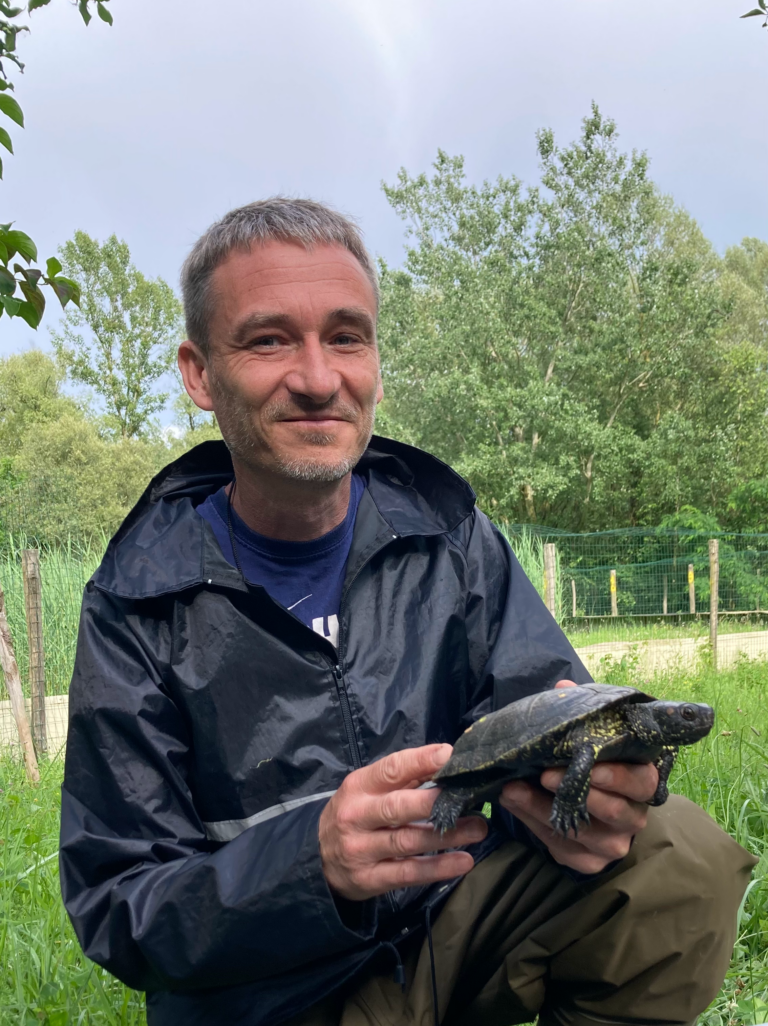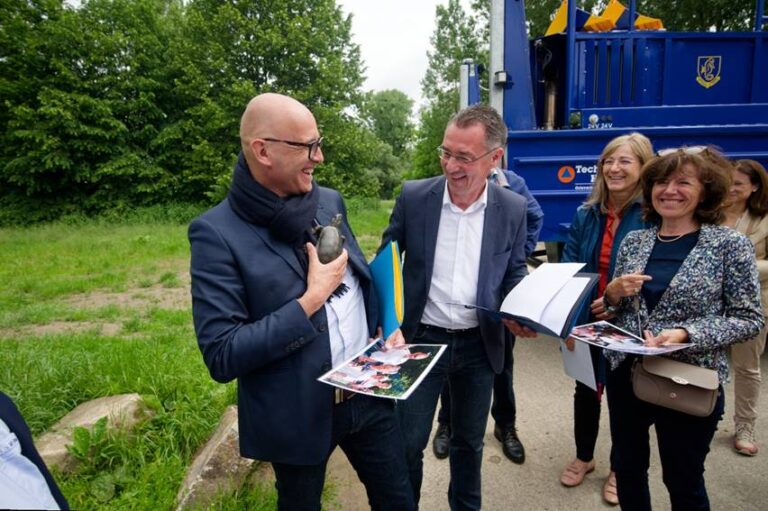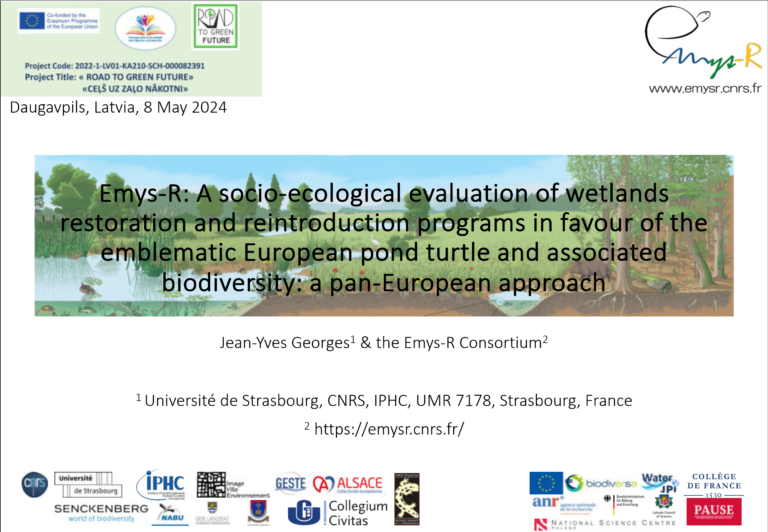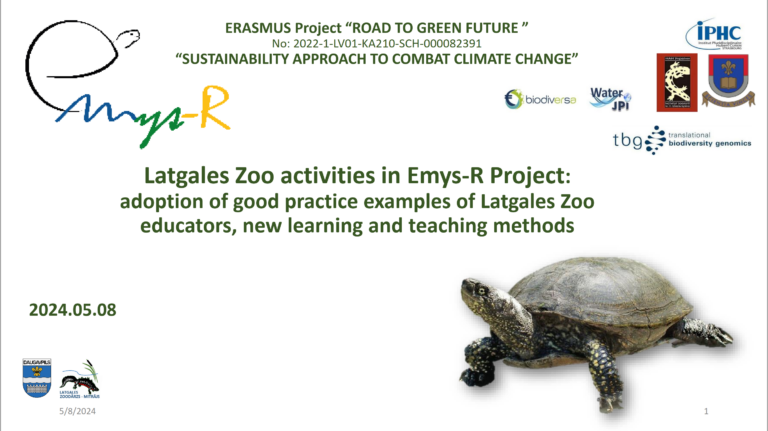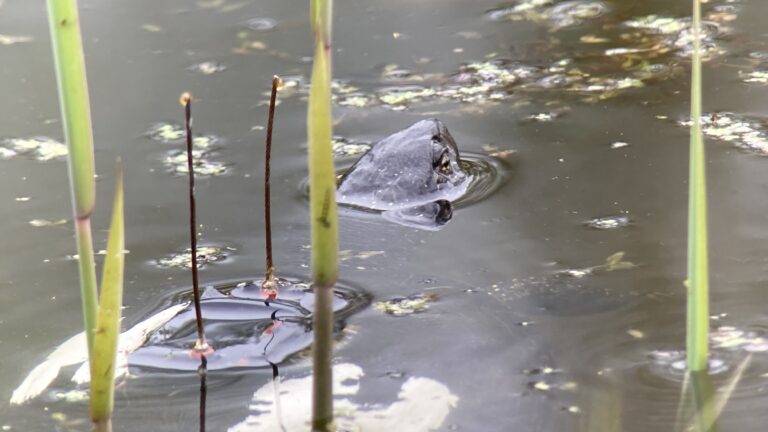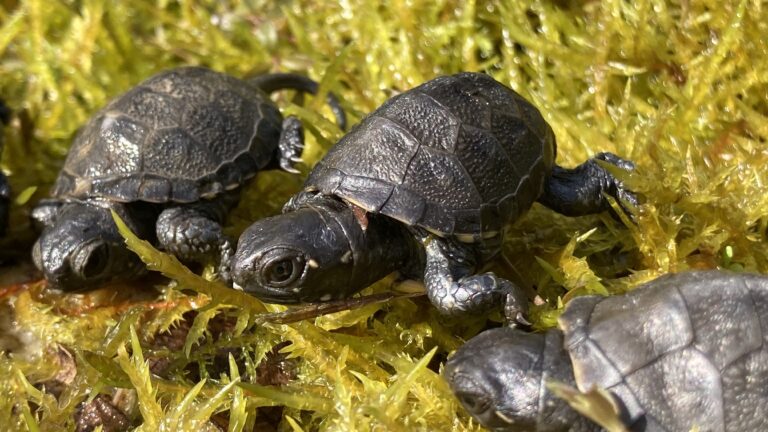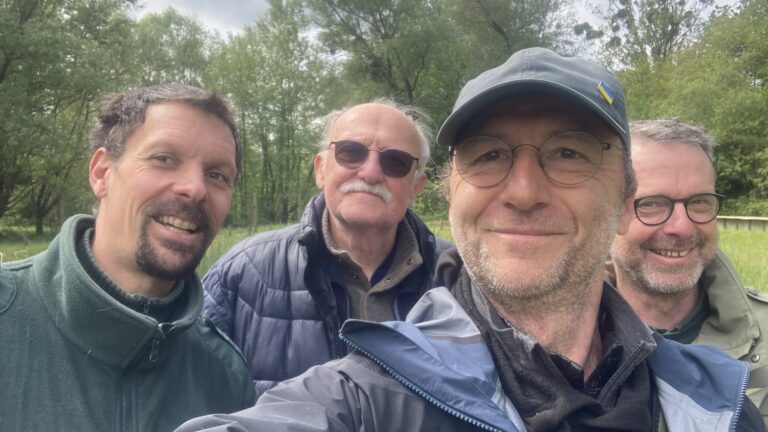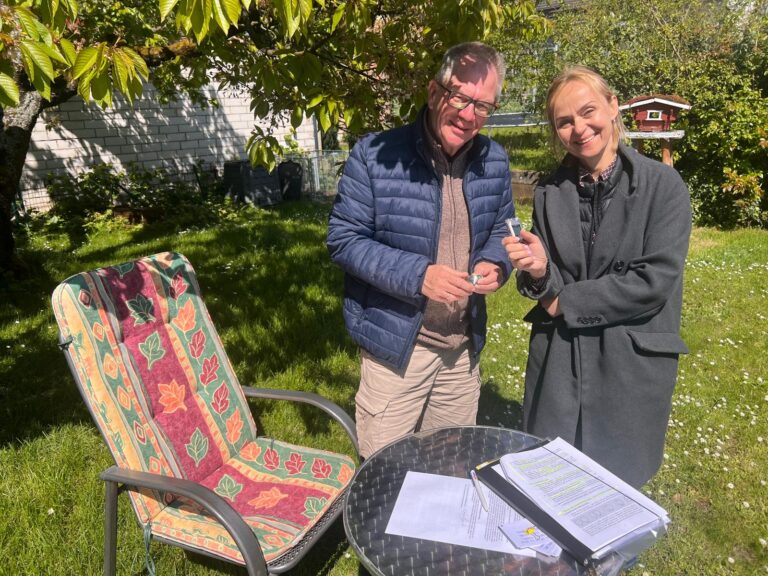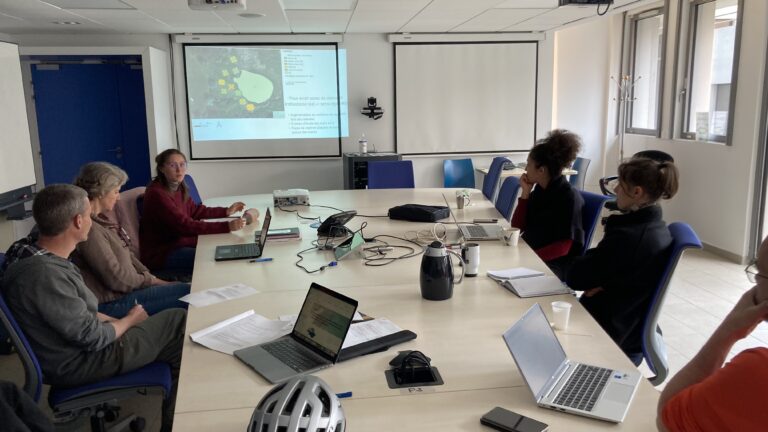Emys-R
A socio-ecological evaluation of wetlands restoration in favour of the European pond turtle Emys reintroduction and associated biodiversity: a pan-European approach

Emys-R is a 3-year participatory action-oriented research project aiming at defining the most effective, socially supported, ecologial methods to restore wetlands in favour of the European pond turtle reintroduction, and associated biodiversity throughout Europe.
🇺🇦 Emys-R stands with Ukraine! 🇺🇦
27-30 June 2024: Emys-R at the Society for the Study of Amphibians and Reptiles 2024 Meeting, University of Michigan, Ann Arbor, MI, USA
Dr Oksana Nekrasova attended a major international conference where she presented The impact of climate change on the prospects for transcontinental two-way invasion of reptiles between Europe and America.
More here

22-28 June 2024: Third WP2 field session in all three study sites
Drs Mihails Pupins and Reinis Brics deployed additional TOTITAGS in Latvia while the NeuWoerr team has been strengthened with David Bock (animal carer, IPHC) and Hugo Salis (apprenti field trainee, IPHC) who had their first field experience on site – monitoring Emys and associated biodiversity sometimes in unconventional manners due to still high water levels, excavating nests laid in 2023, contacting exotic invasive calico crayfish that disperses on the DE side – plus meeting Project manager Dr Kathrin Theissinger (happy birthday!) who joined for assessing water levels in the Woerr gravel pond.
16-21 June 2024: Massive contribution at the World Biodiversity Forum, Davos
All contributions available here

30-31 May 2024: Emys-R invited at the BiodivRestore Knowledge Hub, Paris, France
Dr Jean-Yves Georges attended, as expert of the BiodivRestore Knowledge Hub, a 2-day event aiming for a more sustainable and structural contribution by the European scientific community and knowledge holders in support of the implementation of the EU Nature Restoration Law.

24 May 2024: President of the European Community of Alsace (CeA) and Landrat of the Landkreis Germersheim (KG) meet Emys!
Denis Schwab (Collectivité européenne d’Alsace) and Uwe Meissner (Kreisverwaltung Germersheim, represented by M. Christoph Buttweiler) presented the former INTERREG project “Cistude sans frontière – Sumpfschildkröte ohne Grenze” (2009-2012) during the “cross-border Roadtour” organized as part of Europe Month and in the run-up to the European elections (9 June 9 2024) where Mr. Fréderic Bierry (President of the European Community of Alsace, CeA), Mr. Fritz Brechtel (Landrat of the Landkreis Germersheim), and Ms. Susanne Ganster (Landrätin of the Landkreis Südwestpfalz) enjoyed holding an Emys moulage used for eduction purpose (photo C. Buttweiler).
22-24 May 2024: Emys-R invited at the LIFE Platform Meeting on Amphibian and Reptile Conservation: Challenges and Opportunities in Europe, Santander, Spain
Drs Andris Čeirāns, Kathrin Theissinger and Jean-Yves Georges attended this LIFE platform meeting (more here) aiming at providing practical advice to be addressed to EU-LIFE, IPBES/IUCN experts and policy makers involved in forthcoming EU Nature Restoration Law and EU Life fundings.

13-20 May 2024: Field session on Neu Woerr during heavy floods
During this field session, Master students Julia Collery (WP3, LIVE), Chloé Fernando (WP4, GESTE) and Fanny Kuttler (WP2, IPHC) took part of several field protocols. On 16th May, the equivalent to one entire month of rain felt during 29 continuous hours, offering an exceptional – yet hardly recognizable – pondscape with some risks for the equipment. Beside, first captures of Emys that were released last year by NABU on the land managed by Germersheim Landkreiss, Germany!
12 May 2024: New publication by Marushchak et al. about rare species sightings in Ukraine in 2023
Dr Oleksii Marushchak and colleagues report the list of animal species listed in the Red Data Book of Ukraine that they encountered in Ukraine in 2023, with highlights of the impacts of Russian large scale agression on local biodiversity.
Marushchak et al. (2024) Distribution of rare biodiversity in Ukraine / Series: « Conservation Biology in Ukraine », 38: 243-250.
Read here
8 May 2024: Emys-R at the Erasmus project Road to Green Future
As part of the ERASMUS Project «Road to green future: Sustainable approach to combat climate change» (more here) hosted by Daugavpils University, Drs Mihails Pupins and Jean-Yves Georges presented major achievements of Nature-based-Solutions research and educational projects to a delegation of 15 teachers from Italy, Spain and Turkey.
More here
3-11 May 2024: Joined WP2 field session in Latvia
Project leader Jean-Yves Georges visited Pr Arturs Škute and Dr Mihails Pupins for major improvements in WP2 actions in Latvia, with 1) the deployment of the newest TOTITAGS (Sextant Technology Ltd, NZ) for studying the ecology of Emys reintroduced in Silene study site and 2) the sampling of the population of captive Emys -with major support from Dr Vet Reinis and Vet Assistant Virginia at Latgales zoo- for extended genetic assessment of the breeding stock and best management.
3 May 2024: Call for applicants for PhD on Emys
IPHC (CNRS UMR 7178, Strasbourg, France) is looking for a highly skilled and motivated candidate to the entrance examination (concours) of the Doctoral School ED414 at University of Strasbourg, France, for running a PhD project on Comparative behavioral ecology and ecophysiology of the European pond turtle along a latitudinal gradient.
Read the call here
Dateline: 24. May 2024
23 April-4 May: Dr Oksana Nekrasova ran her long term monitoring of the herpetofauna in Uzbekistan
20-27 April 2024: Highly active week on the DE-FR transbordering study site Neu Woerr
For their first field session of the year, WP2 (IPHC) has been running Emys and non-target species survey, WP3 (LIVE & ENGEES) has been implementing measurements and plant translocations in the newly created adaptive ponds, and WP4 (GU, CC and GESTE) performed intensive interviews with German inhabitants and stakeholders. Meanwhile, land managers of the National Office for Forestry introduced their new agent in charge of biodiversity on the Domain Forest of Lauterbourg (FR).
23 April 2024: Welcome to Elżbieta Głowacka-Adamek!
Ela is working as an interpreter and translator in support to interviews run in Germany by WP4
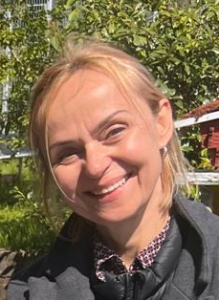
22 April 2024: Nekrasova et al. Fishes published!
🇺🇦 21 April 2024: Open lecture-excursion for 8 students of Kyiv University, Ukraine
Dr Oleksii Marushchak trained 8 highly motivated students (1st, 2nd and 3rd years) in capturing, observing and better knowing for best protecting the herpetofauna of the Kaniv Reservoir, Dniepr River, near the town of Rjychtchiv, Kyiv Region, Ukraine.
18 April 2024: Meeting with land managers and scientists
Land manager of the Woerr FR study site (CeA) and FR scientific force task (IPHC, LIVE and ENGEES) met for discussing forthcoming season protocols, data sharing and long term partnership on the Woerr study site and CNRS-labelled SEE-Life Neu Woerr.
🇺🇦 17 April 2024: Ukraine is the best proof that life and humanity prevail
In their last publication in Responsible Herpetology Journal, Dr Oleksii Marushchak and colleagues from Ukraine published this stunning paper about herpetofauna on the war front and how, despite all risks, people from Ukraine keep taking care of wildlife and life.
Proof that life and humanity will prevail darkness.
Read the article here
12 April 2024: Emys-R becomes a member of the BiodivRestore Knowledge Hub!
In the context of its ‘BiodivRestore’ ERA-NET COFUND Action to support research on “Conservation and restoration of degraded ecosystems and their biodiversity, including a focus on aquatic systems”, Biodiversa+ and Water4All/Water JPI have established a pan-European Knowledge Hub with the aim to strengthen the knowledge base for the implementation of the Nature Restoration Law.
The BiodivRestore Knowledge Hub will take the form of a dynamic ‘community of practice’ and will be composed of two task forces addressing two main objectives: 1) Strengthening the knowledge base of the implementation of the NRL, based on a needs-driven approach; 2) Advance the Research & Innovation Agenda.
Project leader Dr Jean-Yves Georges has been selected as a member of the Knowledge Hub by the selection committee and will attend the first meeting Paris, 30-31 May 2024, Paris, France.

April 2024: a new documentary about L.H. Bojanus
Enjoy this just-came-out documentary about Bojanus, the FR-born, LT-adopted author of the most famous Anatome Testudinis europeaeae (1819). A very pleasant journey throughout Europe and time… by the Cercle d’histoire Alsace-Lituanie (Strasbourg)… so far in Fr, soon in Lithuanian, hopefully in EN too!
Emys-R is funded through the 2020-2021 Biodiversa & Water JPI joint call for research proposals, under the BiodivRestore ERA-Net COFUND programme, and with the funding organisations Agence Nationale de la Recherche (ANR, France), Bundesministerium für Bildung und Forschung (BMBF, Germany), State Education Development Agency (VIAA, Latvia), and National Science Center (NSC, Poland).








